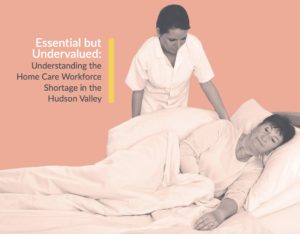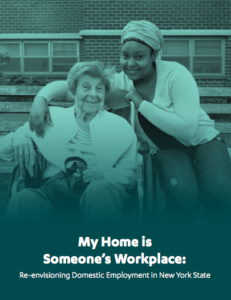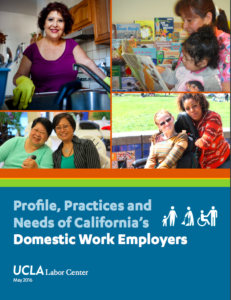Domestic work is an indispensable part of American life. Domestic workers support families and individuals with pressing childcare, home care and house cleaning needs. They support seniors and people with disabilities, making it possible to live at home with dignity.
The lack of research on domestic workers and employers has been a challenge to our work advocating for the support individuals and families need as well as the standards and protections workers deserve. Hand in Hand, along with researchers and labor experts at top universities, are working to change that.
2022: Lives and Livelihoods: California’s Private Homecare Industry in Crisis
Performed against the backdrop of the accelerating need for home care in California and nationally, this report throws light on the current challenges facing both consumers and providers of care. It is based on a multi-method examination of home care in California, and it focuses on two main areas: 1) in-home, private-hire care scenarios in which the employer finds homecare workers directly (direct-hire consumers) or through an agency (agency consumers) ; and 2) care provided in six-bed residential care facilities (RCFEs). We surveyed 500 workers and 103 consumers throughout the state. We also conducted in-depth interviews with six homecare and RCFE workers and 14 consumers in different regions in California and conducted an audit of 62 homecare agencies and 38 RCFEs in the state.
2020: Essential but Undervalued: Understanding the Home Care Workforce Shortage in the Hudson Valley
Home care is the fastest growing workforce in the Hudson Valley, driven by rising demand as life expectancy increases and as baby boomers seek to “age in place.” These vital workers assist with activities of daily living and monitor the health of older adults and people with disabilities, allowing them to live at home instead of in care facilities and nursing homes. Yet low pay, inadequate benefits, and challenging job conditions create great hardship for these workers, leading them to quit the occupation at alarmingly high rates. This pattern exacerbates a mounting labor shortage that leaves many individuals and families without the care they need.
Based on original surveys, interviews, and analysis of official workforce data, this report examines the scope and causes of the Hudson Valley’s home care crisis and identifies strategies to reverse it.
2017: My Home is Someone's Workplace: Re-envisioning Domestic Employment in New York State
This report illuminates the complexities of the domestic employment relationship. It builds from a first-ever representative portrait of the diverse individuals and families who employ domestic workers in New York State. By understanding who domestic employers are, their employment practices, and the challenges they face, we can better understand how to fix our broken care system so that it meets the needs of both employers and the workers in their homes.
2017 Struggles and Support: California’s Homecare Employers
UCLA Labor Center
Home care is an indispensable part of American life and one of the fastest-growing sectors of the healthcare industry. As of 2015, half a million Californians employed homecare workers. Medical advances and a shift away from institutional care have led to a growing need for home care support. Drawing its findings from surveys with 327 homecare employers, this report provides an understanding of homecare employers’ challenges, needs, and employment practices.
2016: Profile, Practices and Needs of California’s Domestic Work Employers
The first comprehensive study of domestic work employers closely examines those who hire for housecleaning, childcare, and homecare services. Based on 501 randomly-dialed phone surveys throughout the state, this study provides demographic and household details, as well as an understanding of the employment practices and needs of domestic employers.





